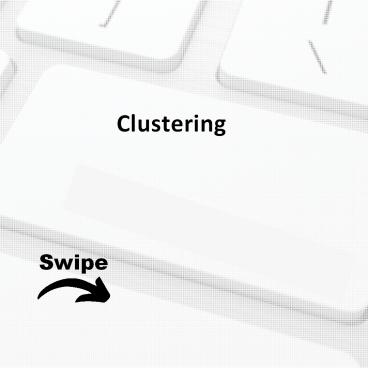Clustering - PowerPoint PPT Presentation
Title:
Clustering
Description:
This presentation educates you about Clustering, Overview, Types of Clustering, Types of clustering algorithms, K-means clustering, Hierarchical clustering, Difference between K Means and Hierarchical clustering and Applications of Clustering. For more topics stay tuned with Learnbay. – PowerPoint PPT presentation
Number of Views:17
Title: Clustering
1
Clustering
Swipe
2
Clustering
Clustering is the task of dividing the population
or data points into a number of groups such that
data points in the same groups are more similar
to other data points in the same group than those
in other groups. In simple words, the aim is to
segregate groups with similar traits and assign
them into clusters.
3
Overview
- Lets understand this with an example. Suppose,
you are the head of a rental store and wish to
understand preferences of your costumers to
scale up your business. Is it possible for you
to look at details of each costumer and devise a
unique business strategy for each one of them?
Definitely not. But, what you can do is to
cluster all of your costumers into say 10 groups
based on their purchasing habits and use a
separate strategy for costumers in each of these
10 groups. And this is what we call clustering.
4
Types of Clustering
Hard Clustering In hard clustering, each data
point either belongs to a cluster completely or
not. For example, in the above example each
customer is put into one group out of the 10
groups. Soft Clustering In soft clustering,
instead of putting each data point into a
separate cluster, a probability or likelihood of
that data point to be in those clusters is
assigned. For example, from the above scenario
each costumer is assigned a probability to be in
either of 10 clusters of the retail store.
5
Types of clustering algorithms
Since the task of clustering is subjective, the
means that can be used for achieving this goal
are plenty. Every methodology follows a different
set of rules for defining the similarity among
data points. Connectivity models Centroid
models Distribution models Density Models
6
K-means clustering
- K-means clustering is one of the simplest and
popular unsupervised machine learning
algorithms. In other words, the K-means
algorithm identifies k number of centroids, and
then allocates every data point to the nearest
cluster, while keeping the centroids as small as
possible.
7
Hierarchical clustering
Hierarchical clustering, also known as
hierarchical cluster analysis, is an algorithm
that groups similar objects into groups called
clusters. The endpoint is a set of clusters,
where each cluster is distinct from the other
cluster, and the objects within each cluster are
broadly similar to each other.
8
Difference between K Means and Hierarchical
clustering
Hierarchical clustering cant handle big data
well but K Means clustering can. This is because
the time complexity of K Means is linear i.e.
O(n) while that of hierarchical clustering is
quadratic i.e. O(n2). In K Means clustering,
since we start with random choice of clusters,
the results produced by running the algorithm
multiple times might differ. While results are
reproducible in Hierarchical clustering.
9
K Means is found to work well when the shape of
the clusters is hyper spherical (like circle in
2D, sphere in 3D). K Means clustering requires
prior knowledge of K i.e. no. of clusters you
want to divide your data into. But, you can stop
at whatever number of clusters you find
appropriate in hierarchical clustering by
interpreting the dendrogram
10
Applications of Clustering
- Clustering has a large no. of applications spread
- across various domains. Some of the most popular
applications of clustering are - Recommendation engines Market segmentation
Social network analysis Search result grouping
Medical imaging - Image segmentation Anomaly detection
11
Topics for next Post
Classification and regression trees
(CART) Neural Networks Stay Tuned with































